The South East region of England covers a number of counties to the south and immediate west of London. It covers the counties of Kent, Surrey, West Sussex, East Sussex, Hampshire, Berkshire, Buckinghamshire, Oxfordshire and the Isle of Wight.
In 2005, the Conservatives won 58 seats, Labour won 19, and the Liberal Democrats won six.
The recent redistribution saw four of Labour’s seven seats in Kent move into the Conservative column. However, the redrawing of the boundaries between the two seats in Milton Keynes saw the northern seat switch from Conservative to Labour. The redistribution also saw the Labour seat of Oxford East reclassified as a Lib Dem seat and the Portsmouth North as a Cosnervative seat. An extra seat was created in Hampshire, producing an overall figure of 63 Conservative, 14 Labour and 7 Liberal Democrat. It should be noted, however, that Conservative MP John Bercow (Buckingham) was elected Speaker in 2009, and will not be seeking re-election as a Conservative, and will not be opposed by any of the three major parties.
The Conservatives dominate the South East of England, even at their lowest point. In 1992 the Conservatives managed to hold all but two seats in the region, with Labour only holding one seat in Oxford and one in Southampton, and with the Liberal Democrats holding no seats in the region.
Most of Labour’s seats lie in urban areas. They hold two in Southampton, one in Portsmouth, one in Oxford and both seats in Milton Keynes. Labour also holds all three seats in Brighton and Hove, one seat in Reading and Slough. They also hold three seats along the coast of Kent and East Sussex. Labour also holds five seats in northwestern Kent, close to London and the Thames.
Almost every Labour seat in the South East is a marginal constituency with a margin of less than 10%. Labour’s two Southampton seats, two Berkshire seats, and two others along the coast are not classified as marginal, although it has been suggested that Brighton Pavilion and Dover are still highly vulnerable. With the exception of Oxford East and Brighton Pavilion, all of these marginals are under threat primarily by the Conservatives. This suggests that Labour is at risk of being almost entirely wiped out in the South East.
The Liberal Democrats hold seven seats: Lewes in Sussex, Oxford West & Abingdon, Oxford East and four seats in Hampshire. Three of those Hampshire seats, including Portsmouth South and two seats around Southampton, are all considered marginal, and are all vulnerable to the Conservatives. Oxford East, while notionally Lib Dem, is held by Labour and very marginal. A majority of seats in South East England are Conservative seats where the Liberal Democrats came second. There is only one Labour seat where the Liberal Democrats are in with a chance of winning. This makes it likely that, if the Conservatives perform strongly, the Liberal Democrats will lose seats to the Conservatives without gaining much ground from Labour.
The Conservatives hold most seats, including almost all outside major centres. The Tories hold all seats in Surrey and all but one in West Sussex. The Conservatives’ main challenger in most of the seats are the Liberal Democrats, but in the current environment these seats should be relatively safe.
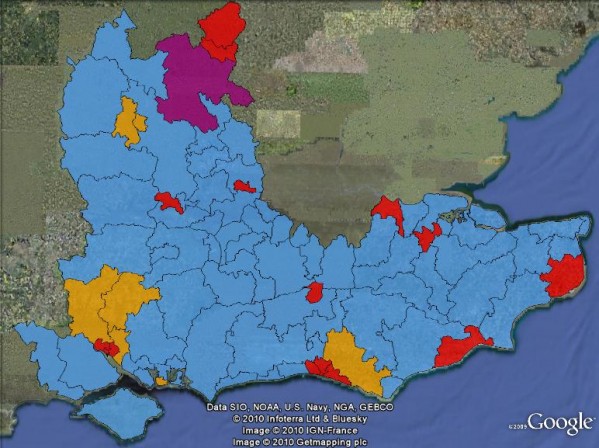
Recent history
- 1987 – 76 CON, 2 LAB
- 1992 – 77 CON, 2 LAB
- 1997 – 54 CON, 22 LAB, 7 LD
- 2001 – 53 CON, 22 LAB, 8 LD
- 2005 – 58 CON, 19 LAB, 6 LD
In 1987, the Conservatives won a decisive victory in the South East, almost wiping out Labour. They held 76 seats, with Labour only holding the seats of Oxford East and Newbury. The 1992 election was almost an exact repeat. Labour retained Oxford East, gained Southampton Itchen and lost Newbury. The Conservatives also gained a seat due to Milton Keynes being broken into two seats.
The 1997 Labour landslide saw Labour gain ground in the South East, but the Conservatives still held 65% of the seats. Labour gained twenty extra seats, the Liberal Democrats won seven seats, and the Conservatives lost 23. Labour won pairs of seats in Milton Keynes, Reading and Southampton, as well as all three seats in Brighton and Hove. They also won seven seats in Kent, including five in the northwestern corner of the county near London. The Liberal Democrats won three seats in Hampshire, a seat in Oxford, and three others.
The Labour Party maintained their twenty-two seats in 2001, but there were three seats that changed. The Liberal Democrats gained two Conservative seats but lost the Isle of Wight.
The Conservatives regained five seats in 2005. They regained three seats off Labour and two off the Liberal Democrats.
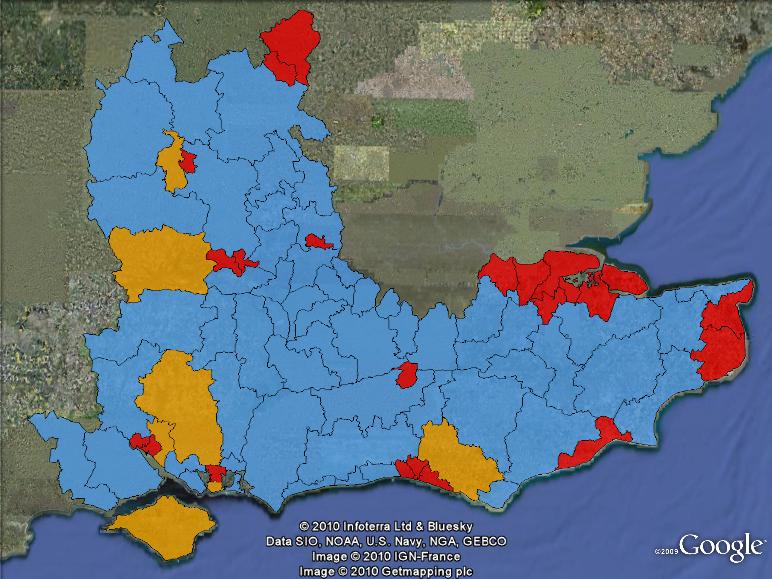
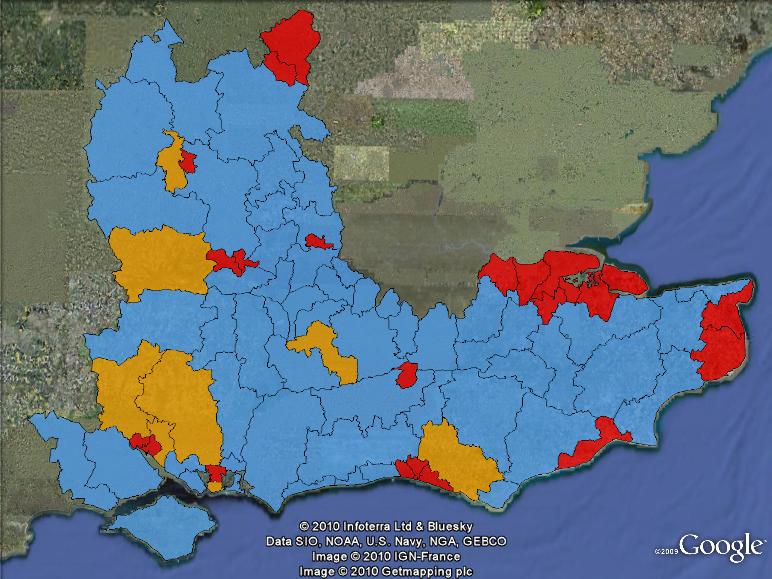
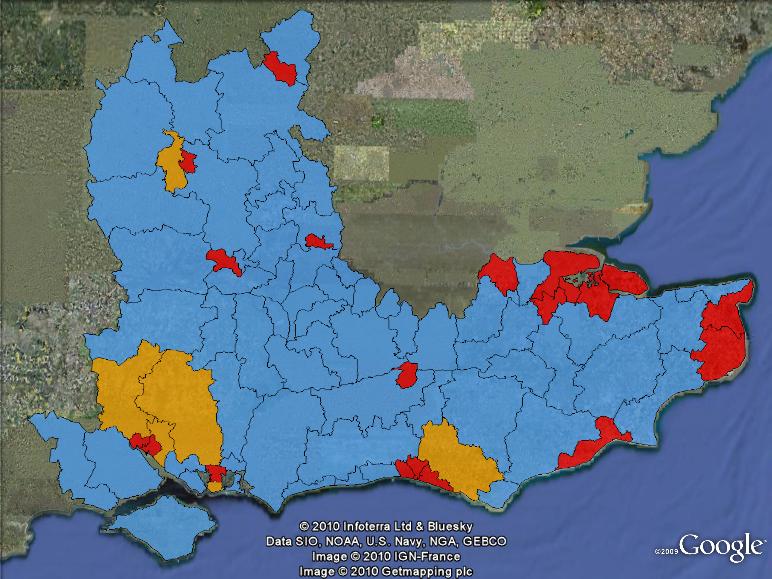
The key seats
- Oxford East – The only seat in the South East that is a contest between Labour and the Liberal Democrats. The seat has been held by Labour’s Andrew Smith since 1987, and he is being challenged by the Liberal Democrats. Rallings and Thrasher defines this as being held by Labour with a 0.7% margin, while UK Polling Report defines it as having a 0.4% swing for the Liberal Democrats. Either way, if Labour is on their way down this seat should be a Lib Dem gain in 2010.
- Eastleigh, Portsmouth South, Romsey & Southampton North – these three Hampshire constituencies are Liberal Democrat marginals. Eastleigh and Romsey lie on the fringe of Southampton, and are ninth and eleventh respectively on the Conservative target list. Portsmouth South is slightly safer, but is still well within the reach of the Conservatives if they are on track to be the largest party in the Commons. Eastleigh has been held since 2005 by Lib Dem shadow home secretary Chris Huhne, who was the runner up in the 2005 and 2007 Liberal Democrat leadership contests.
- Brighton Pavilion – this seat is the top national priority for the Green Party, who are standing Caroline Lucas, the party’s leader and Member of the European Parliament since 1999. Recent results in European and local elections and local polling suggest the Greens are coming first in Brighton, although they came third in Brighton Pavilion in 2005. Both Labour and Greens are using differing interpretations of the political landscape in their leaflets to convince left-wing voters to vote for them as the best chance to defeat the Conservatives.
- Eastbourne, Guildford, Meon Valley, Newbury – these four Conservative seats are respectively 6th, 3rd, 12th and 20th on the Liberal Democrat target list. In a good year, they could be vulnerable (and two of them were held by the Lib Dems prior to 2005), but should be safe in the current circumstances.
- Brighton Kemptown, Hove, Portsmouth North – these three Labour seats all lie in larger coastal towns and are extremely vulnerable to the Conservatives. Brighton Kemptown and Hove are 29th and 8th respectively on the Tory target list. UK Polling Report has judged that the redistribution makes Portsmouth North the first seat on Labour’s target list
- Milton Keynes North, Milton Keynes South – These two seats have been redrawn since 2005. The Conservatives won back the North East Milton Keynes constituency in 2005, but the redistribution has created two Labour marginal constituencies. The northern seat is 36th on the Conservative target list, the southern seat is 7th. Sitting Conservative MP Mark Lancaster is standing in Milton Keynes North.
- Chatham & Aylesford, Dartford, Gillingham & Rainham, Rochester & Strood, Sittingbourne & Sheppey – There is a cluster of six seats (along with Conservative-held Gravesham) in northwestern Kent east of London and south of the Thames. UK Polling Report has judged that the redistribution has flipped three of these five Labour seats to the Conservative column. Dartford is twelfth on the Conservative target list, while Chatham & Aylesford is 113th. In the case of a substantial swing to the Conservatives this area is likely to turn entirely blue, as it was prior to Blair’s 1997 landslide.
- Dover, Hastings & Rye – These two Labour seats lie on the southeastern coast of England. Hastings is 21st on the Conservative target list, and Dover is 89th.
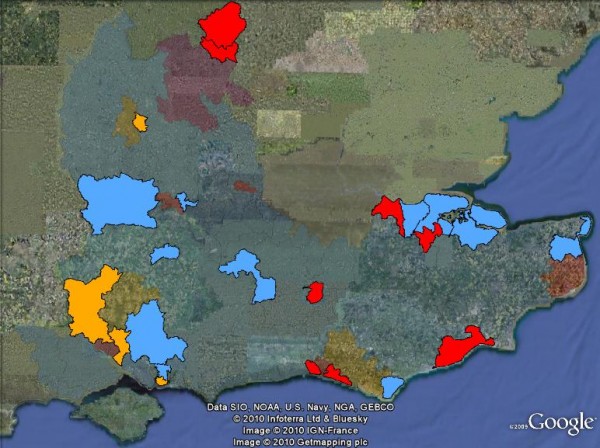
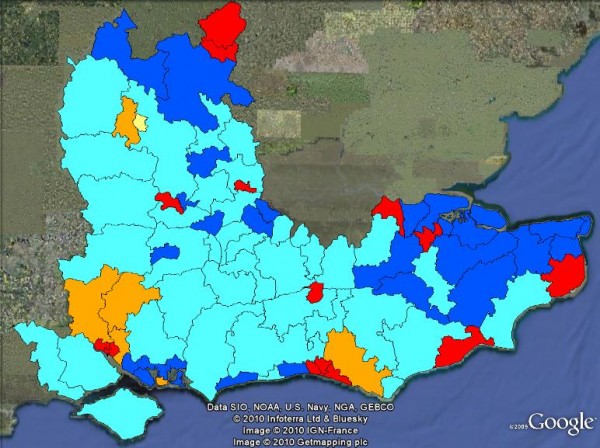


Readers might like to note that UK Polling Report’s listing of seats by region has a lot more seats listed for South East for some reason. Don’t make the mistake I’ve made of using their list to work out which seats are in which region.
The share of the vote across the region in 2005 was: CON 45.0%, LD 25.4%, LAB 24.4%. Note Labour won three times as many seats as the Lib Dems despite getting a lower share of the vote.
http://www.smh.com.au/world/clegg-the-clear-winner-as-british-party-leaders-joust-in-historic-tv-debate-20100416-si88.html
Clegg ‘clear winner’ of first televised debate (ever!).
Yep, everyone seems to think Clegg won. I personally found it pretty dull and boring.
I’m warming to Clegg, but I still don’t like him anywhere near as much as I liked Charles Kennedy. Clegg seems to be trying to be too populist, and they seem to often take positions that would appear to contradict their liberal philosophy. Kennedy on the other hand was very good at talking about issues in the deeper context of liberal philosophy. (Of course, Clegg is also from the free market liberal wing of the party, whilst Kennedy was from the social liberal wing)
Btw, anyone who had been trying to watch the BBC’s live election videos, but found they were being blocked – as of yesterday it seems they aren’t being blocked any more – last night you could watch the Green Party’s manifesto launch for instance:
http://news.bbc.co.uk/2/shared/election2010/liveevent/
Oh, that was my other question: To what extent should we look at turnout in assessing the size of potential swings in individual seats? Could it be assumed that there could be bigger swings in seats where there was particularly low turnout in 2005?
I tend to think not. Just because a Government is seen as being on the nose doesn’t seem to change turnout much. Disinterested people remain disinterested unless there’s a huge reason to catch their interest, and I don’t see that in this election. Just my thoughts.
I’ve been doing some capmaigning in Oxford West and Abingdon for the LibDem incumbent. The tories are a threat here, did very well in the last local giovt elections, but it is a likely LD retain. Oxford East seems very likely to eb a LD gain – Labour are not doing a lot of campaigning there it seems.
I’m a bit surprised about the debate reaction. I thought Brown did a good job actually. Clegg was solid and obviously did well in that most people won’t have been familiar with him so got a pleasant surprise. He missed quite a few opportunities to push harder, and wasted some of his time restating the question or repeating himself.
Ben, I think you’ve missed Crawley in the key seats list. It’s the most marginal Labour seat in the region I think.
Further up the target list the betting markets have the Tories favourites to gain Reading West, where the sitting Labour MP is retiring.
My interim prediction for this region, to be updated closer to polling day: CON 72, LAB 4, LD 7, Green 1.
In way of interesting seats, Bercow’s Buckingham is the UKIP’s best best. They’re running former leader Nigel Farage against Bercow. Again, they won’t win, but it will be interesting to watch.
My prediction: CON 72, LAB 3, LD 8, Green 1. (Counting the Speaker’s seat as a CON hold)